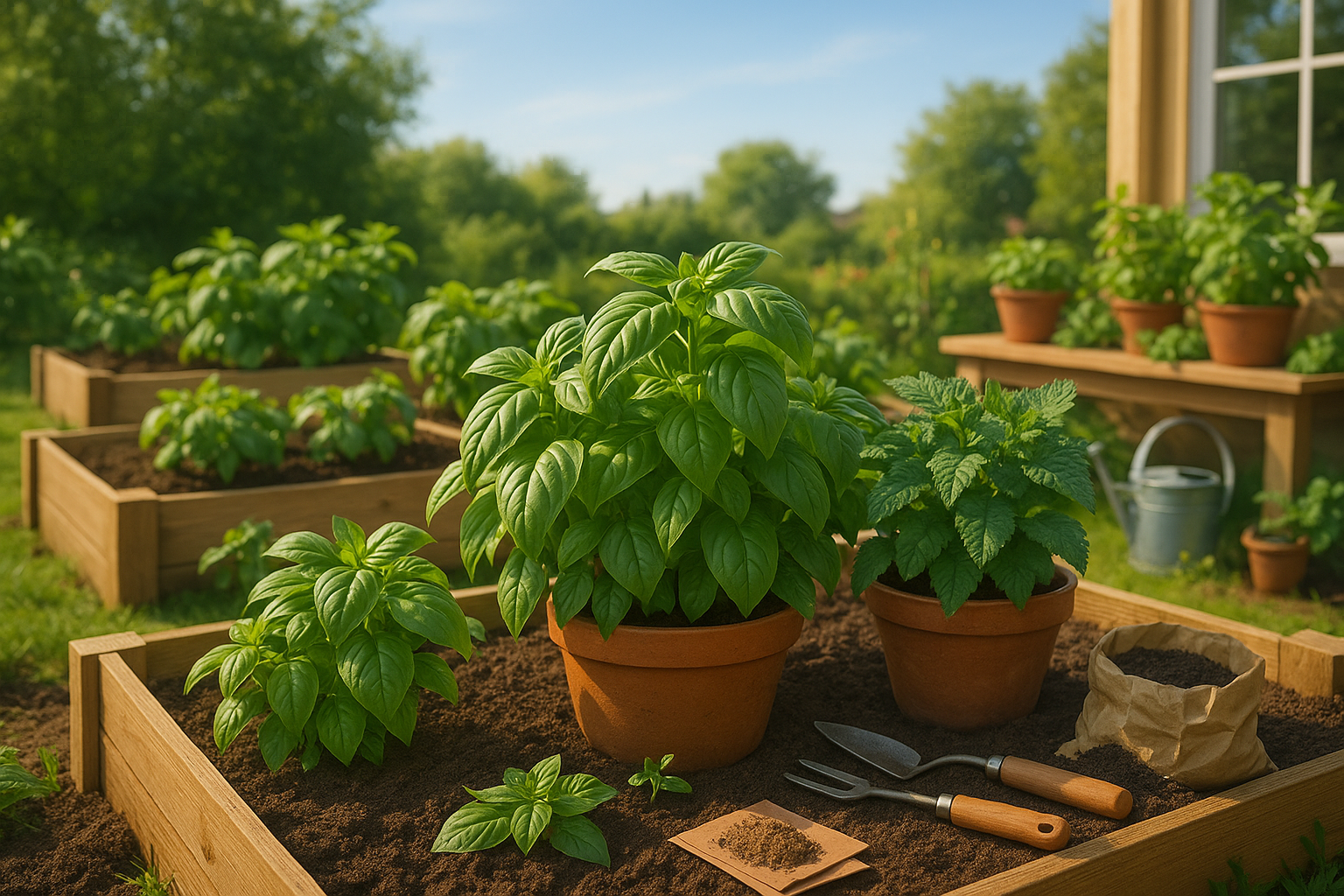Why Raised Beds Are Ideal for Growing Basil
Raised beds offer many advantages over traditional in-ground gardens, making them especially perfect for growing basil. One of the biggest benefits is soil control—raised beds let you customize the soil mix to be rich, loose, and well-draining, which basil loves. Unlike native ground soil, which can be rocky, compacted, or depleted, raised beds can be regularly amended with compost and organic matter, ensuring your basil gets all the nutrients it needs.
Raised beds also improve drainage, which is critical for basil. Too much moisture around the roots often leads to rot and disease, but with the elevated setup, excess water quickly drains away. Accessibility is another major perk, particularly for gardeners of all ages and abilities. Raised beds reduce the need for bending and kneeling, making tasks like planting, weeding, and harvesting easier on your back and knees.
This structure also helps keep pests and weeds at bay, allowing basil to thrive with less chemical intervention. For beginners, raised beds are less intimidating and simpler to manage—fewer weeds, less guesswork with soil, and more consistent results. Experienced gardeners love them too, because they can experiment with companion planting, succession crops, and tailored fertilizer regimens in a controlled environment.
Whether you’re just starting out or have a few seasons under your belt, raised beds create the perfect foundation for lush, flavorful basil, transforming any outdoor space into a productive herb garden.
Choosing the Right Raised Bed Location and Size
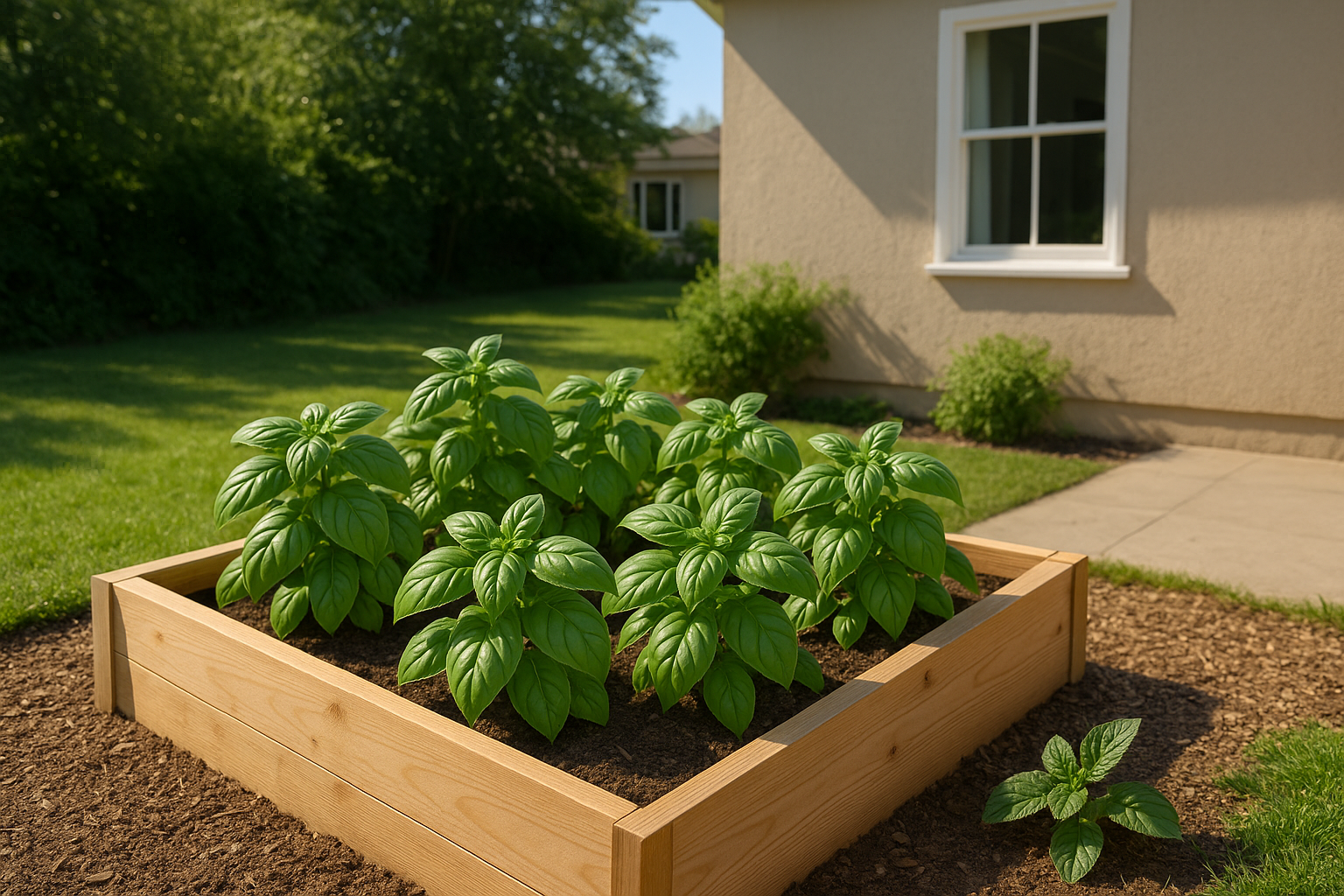
When it comes to growing healthy, flavorful basil, choosing the right raised bed location and size can make all the difference. Basil thrives in sunlight—aim for a spot that gets at least six hours of direct sun daily. This keeps plants robust, boosts essential oil production, and naturally wards off fungal diseases.
Good airflow is just as important. Avoid planting basil near fences or dense shrubs that may block breezes and create humid, stagnant air, which invites pests and mildew.
For sizing, think ahead: a standard recommendation is to space each basil plant at least 8-12 inches apart. For just a few plants, a 2×2-foot bed is plenty. But if you’re dreaming of bountiful harvests for pesto, salads, or drying, go for a larger area—say, 4×4 feet or more. This gives your plants room to breathe and makes harvesting easier.
The bed’s location also impacts garden upkeep directly. Planting closer to your kitchen or patio makes quick snips for dinner a breeze and helps you spot early signs of pests or disease before they spread. Raised beds in open, sunny areas are less likely to become moisture traps, reducing common problems like root rot, slugs, and aphids.
In summary, a sunny, airy location, smart bed sizing, and strategic placement not only encourage a thriving basil crop but also make tending and enjoying your fresh herbs easier than ever.
Preparing Soil for Basil Success
Getting your soil right is the secret to lush, flavorful basil. Start by choosing a spot with loose, well-draining soil—basil hates “wet feet,” which can lead to root rot. The ideal soil should be fertile with plenty of organic matter, and a pH between 6.0 and 7.5 keeps basil happiest.
If your native soil feels heavy or sticky, mix in compost or well-rotted manure to boost nutrients and improve drainage. Adding a couple of handfuls of perlite or coarse sand can further prevent soggy conditions.
Throughout the growing season, feed the soil by regularly adding a thin layer of organic compost or worm castings at the base of each plant, gently working them into the top inch of soil. Mulching with straw or shredded leaves helps the soil retain moisture, fend off weeds, and keep the roots cool in hot weather.
For best results, water in the morning and avoid over-watering; basil likes consistent moisture but not overly soggy soil. Rotate basil’s planting spot each year to prevent disease buildup, and don’t overfertilize—too much nitrogen can encourage leaves with less flavor.
Avoid common mistakes like planting basil in dense clay, acidic soil, or leaving it in standing water after heavy rain. Always check the soil by touching it: if it feels cold or waterlogged, let it dry before watering again.
By preparing the soil with care and making small improvements throughout the season, you’ll set the stage for healthy, aromatic basil that keeps your kitchen well-stocked.
Basil Spacing Guidelines in Raised Beds
When planting basil in raised beds, giving each plant enough room is key to healthy growth and abundant harvests. For traditional sweet basil, aim for 10 to 12 inches (25–30 cm) between plants and at least 12 inches (30 cm) between rows. Larger varieties, like Genovese or lettuce-leaf basil, need a bit more space—leave 14 to 18 inches (35–45 cm) between them. Dwarf or bush varieties, on the other hand, can do well with just 6 to 8 inches (15–20 cm) apart.
For layout, single-row planting keeps things neat and allows for easy airflow and access but may waste space in wider beds. Staggered or triangular spacing, where you offset each row so plants aren’t directly in line with each other, helps maximize planting density while maintaining airflow and reducing disease risk—a great option for squeezing more plants into smaller spaces.
Cluster planting (three to five seedlings together in one spot) can create lush patches and is ideal for cut-and-come-again harvesting. However, overcrowding may lead to poor air circulation and higher susceptibility to fungal issues.
To maximize space, try interplanting short basil varieties with taller veggies like tomatoes or peppers—basil can benefit from dappled shade and make use of areas that might otherwise be wasted. Also, regularly prune plants to prevent them from sprawling, which helps keep them compact and productive.
Always check for signs of overcrowding—yellowing leaves, stunted growth, or pest problems are clues that it’s time to thin. In all cases, good air movement and sunlight are crucial, so when in doubt, err on the side of giving your basil a little extra space to keep it thriving in a raised bed.
Companion Planting with Basil
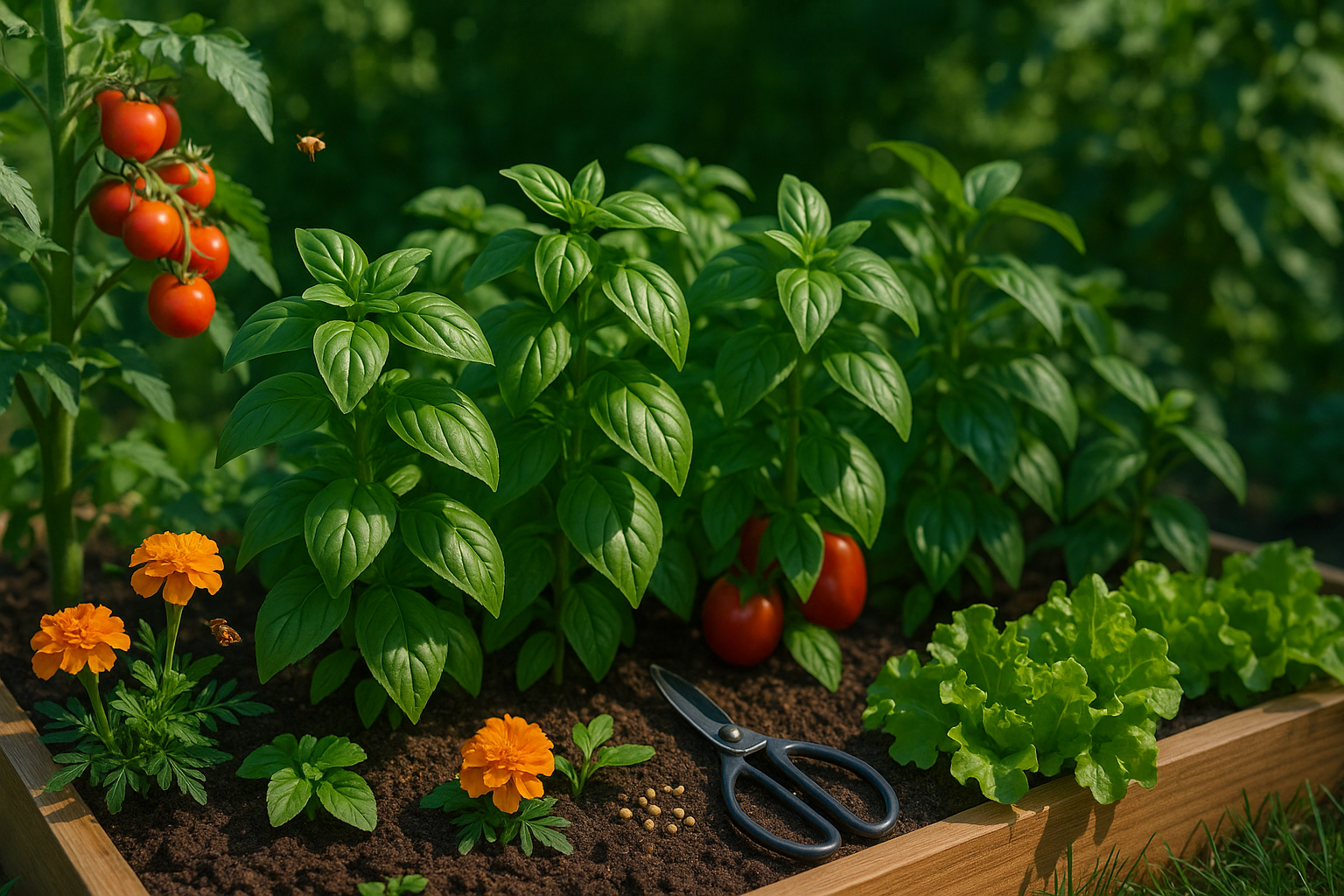
Basil is a garden favorite not only for its versatile flavor but also for its ability to boost the growth and health of nearby plants. Some of the best companions for basil include tomatoes, peppers, lettuce, and marigolds.
Planting basil near tomatoes, for instance, can enhance the flavor of both crops and may help repel pests like aphids and tomato hornworms. Peppers also thrive next to basil, benefiting from the pest-deterrent properties of its fragrant oils. Lettuce, with its shallow roots, pairs well with basil, allowing both plants to flourish without competing for resources. Meanwhile, marigolds add another layer of natural pest control while brightening up the garden bed.
However, not all plants are ideal neighbors. Basil should be kept away from crops like cucumbers, sage, and rue. Cucumbers tend to stunt basil’s growth, while sage and rue can inhibit its development.
Raised Bed Design Tips
For raised bed planting, try interplanting basil in the gaps between tomato or pepper plants, using a zig-zag or checkerboard pattern. You can also edge your raised bed with alternating basil and marigold plants for an attractive look that doubles as pest protection. Another idea is to group basil in clusters near lettuces, creating a mini herb-and-salad section that’s easy to harvest.
With its compact size and flexible growth habit, basil fits easily into most garden layouts, offering both practical benefits and fresh flavor right at your fingertips.
Care, Harvesting, and Maintenance Tips
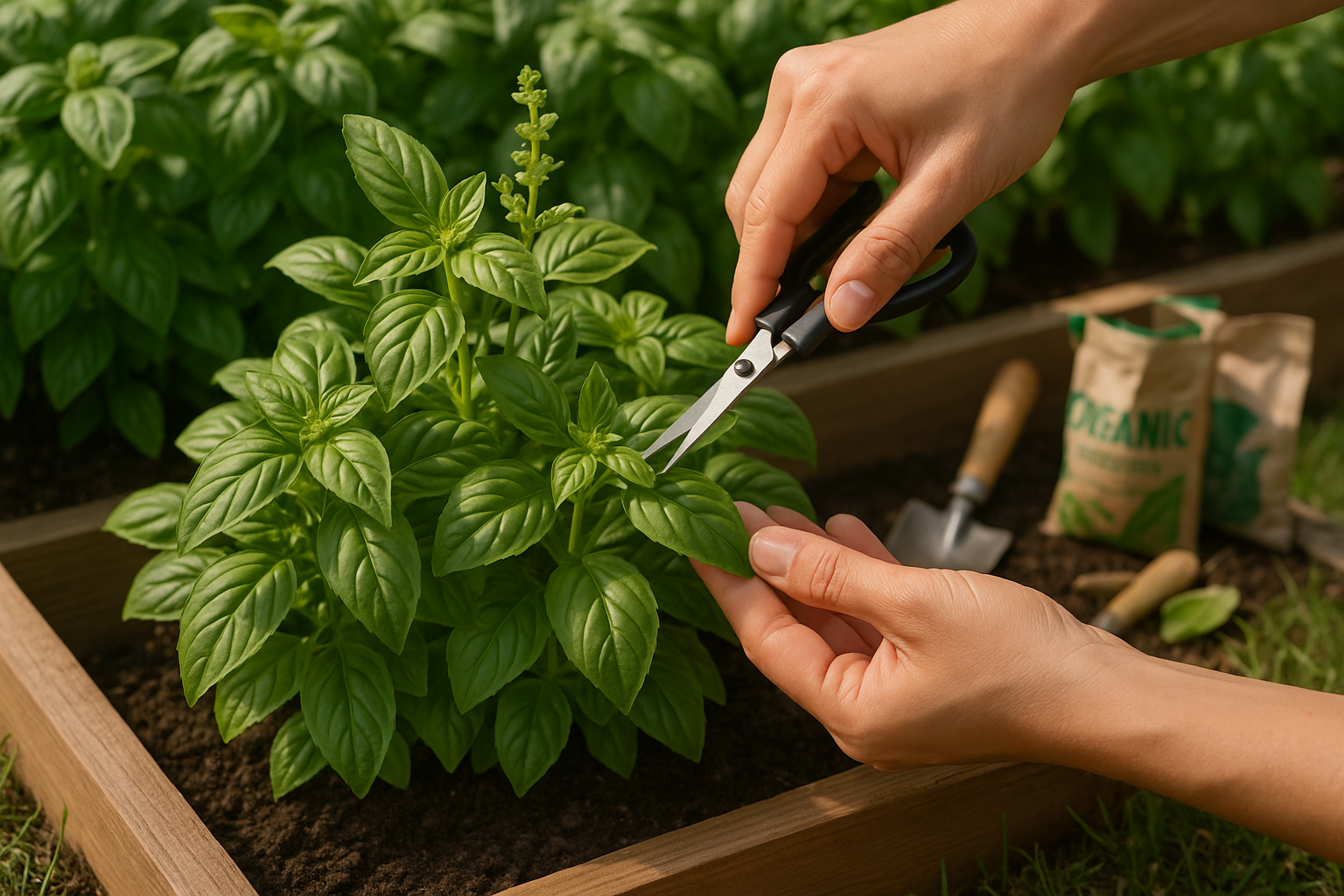
Caring for basil in raised beds is all about consistency and attention to detail. Water your basil early in the morning, aiming for deeply soaked but never soggy soil. In hot climates, this may mean watering every other day, but always check soil moisture before adding more.
Feed your plants with a balanced, organic fertilizer every four to six weeks, opting for lower nitrogen levels to keep growth lush without sacrificing flavor. Pruning regularly is key—pinch back stems just above a set of leaves whenever your basil looks leggy. Always remove flower buds as soon as they appear to prolong leaf production and enhance taste.
When harvesting, pick the leaves from the top of the plant, never stripping full stems bare. This encourages bushier regrowth and ensures a steady supply of tender, aromatic leaves throughout the season.
If you notice your basil getting crowded or air circulation is poor, thin out the plants early—leaving only the strongest every 10 to 12 inches—which reduces the risk of powdery mildew. Should you spot yellowing leaves or fuzzy white patches, trim off affected areas immediately and consider a neem oil spray.
Rotating your raised bed crops each year and keeping mulch pulled back from stems can also help prevent fungal issues. By tending your basil bed regularly and using a few preventative tactics, even gardeners new to raised beds can look forward to lush, flavorful harvests all summer.
Creative Raised Bed Layout Examples for Basil
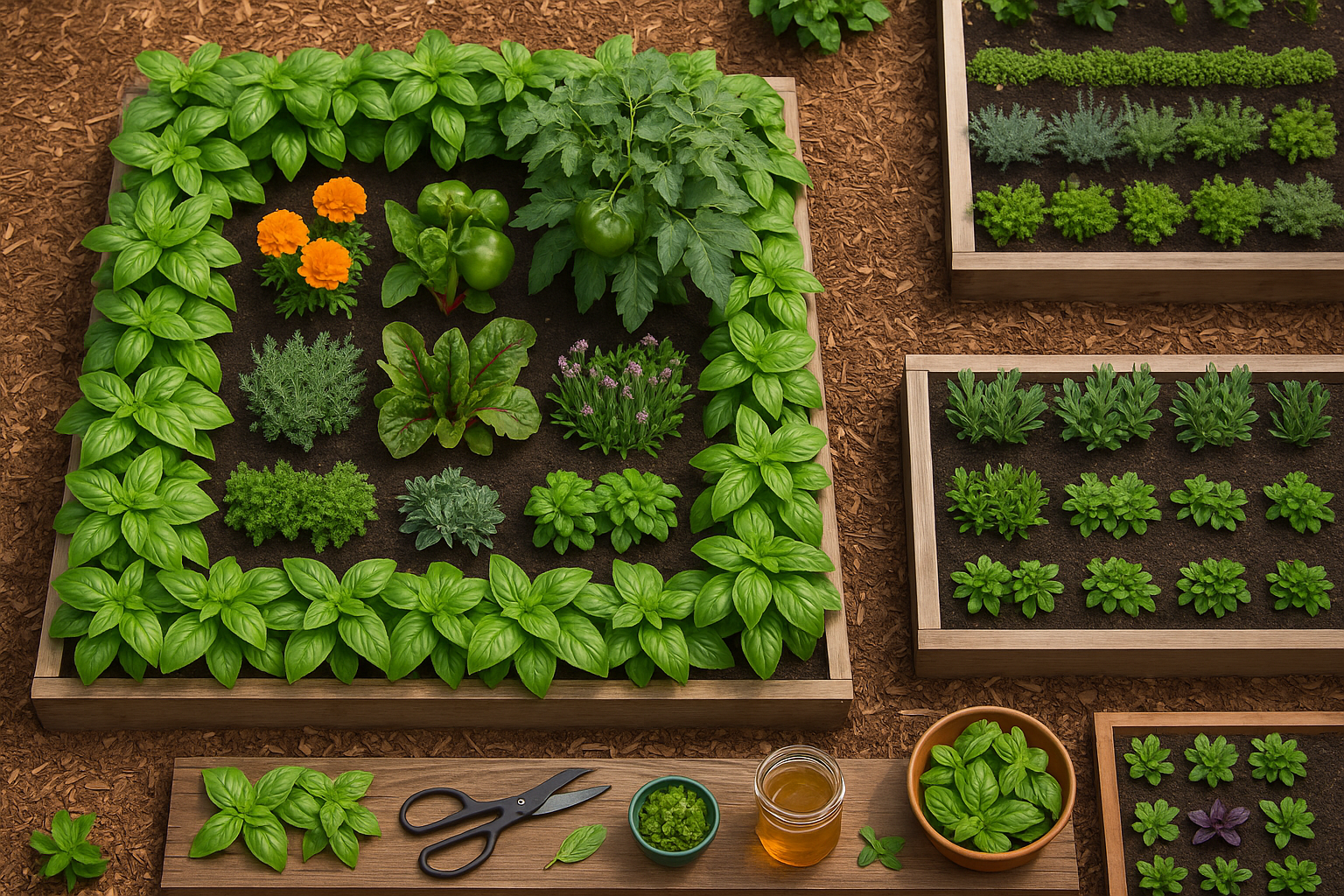
Designing your raised bed for basil can be both practical and fun, allowing you to maximize space while tailoring the layout to suit your cooking habits. For a 4×4-foot bed, try creating a basil border by planting basil around the edges and leaving room in the center for taller veggies or flowers. This not only looks attractive but also makes harvesting easier.
In a 4×8-foot bed, mixed herb rows work well: alternate rows of basil with companion herbs like oregano, thyme, or parsley to create a thriving mini herb garden for a variety of culinary uses. Another creative option is a themed culinary bed—dedicate one corner to a “pesto patch” filled with different basil varieties, while leaving space elsewhere for tomatoes and garlic. This setup is perfect for home chefs who love Italian dishes.
Remember, your choices should reflect the foods you like to make; for example, frequent tea drinkers might mix in mint or lemon balm. Don’t be afraid to experiment! Customize your raised bed layout by mixing shapes such as curved rows, checkerboard patterns, or even spirals to suit your yard and kitchen needs. The best beds are those that inspire you to cook and enjoy fresh herbs regularly.
